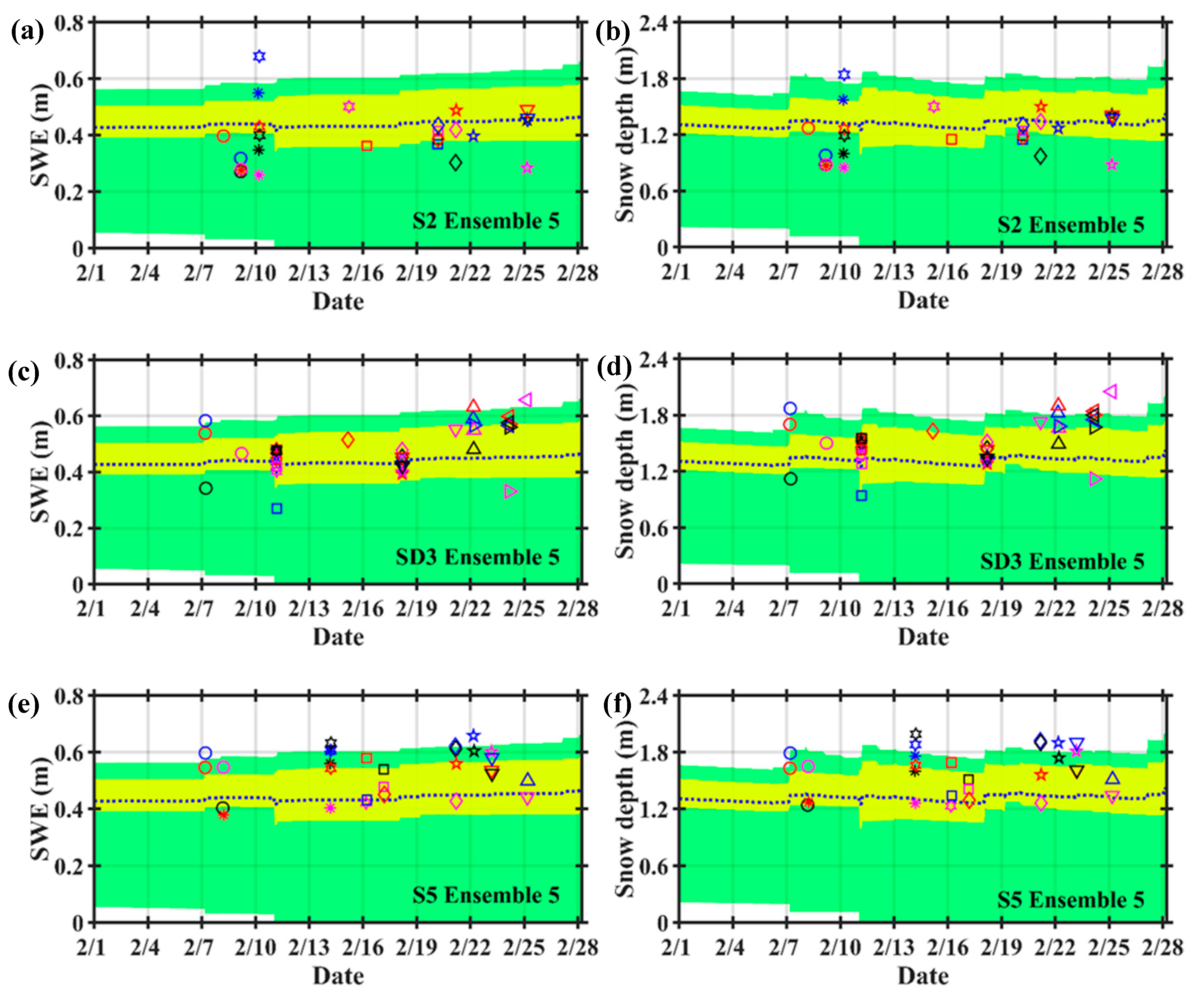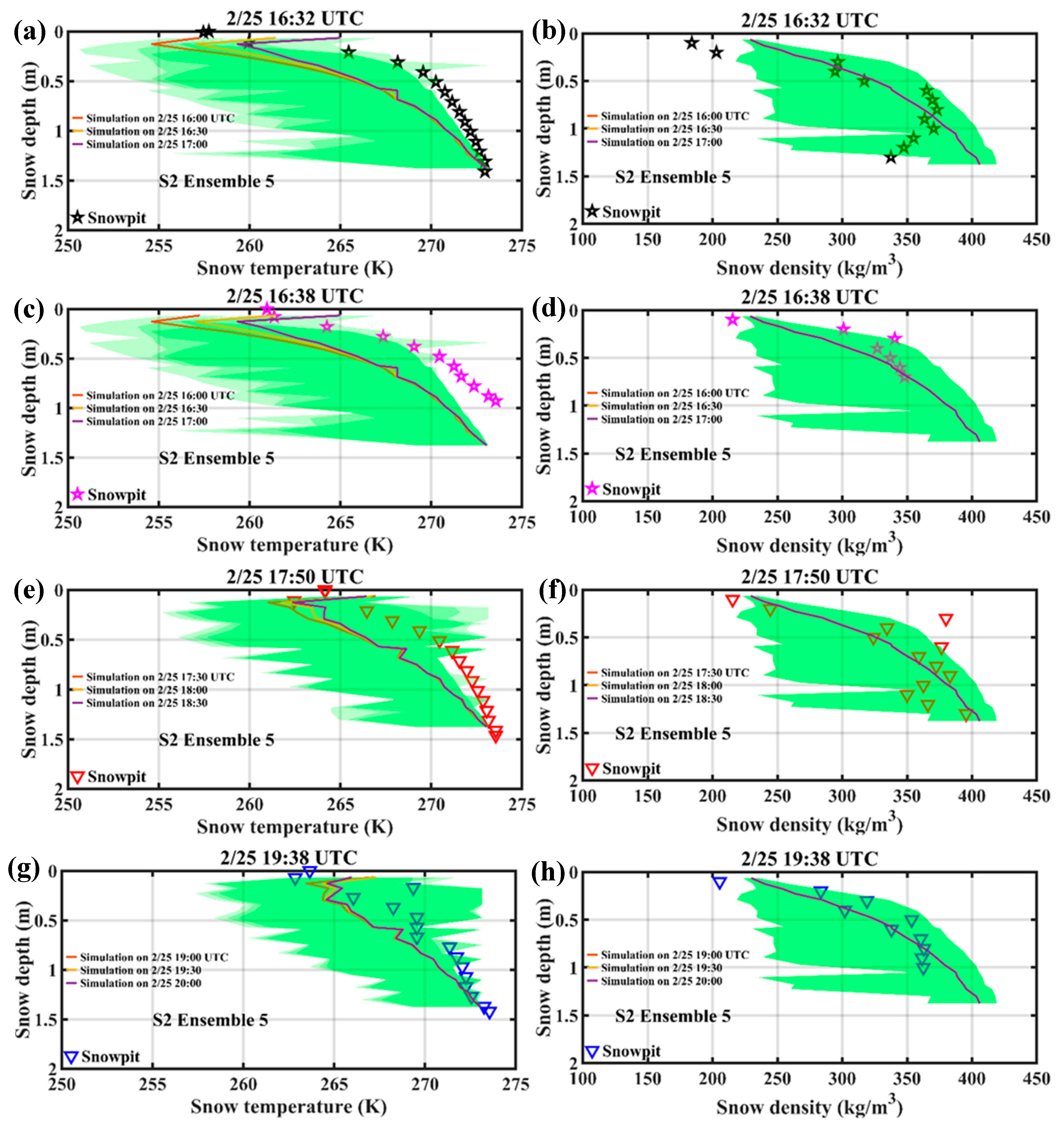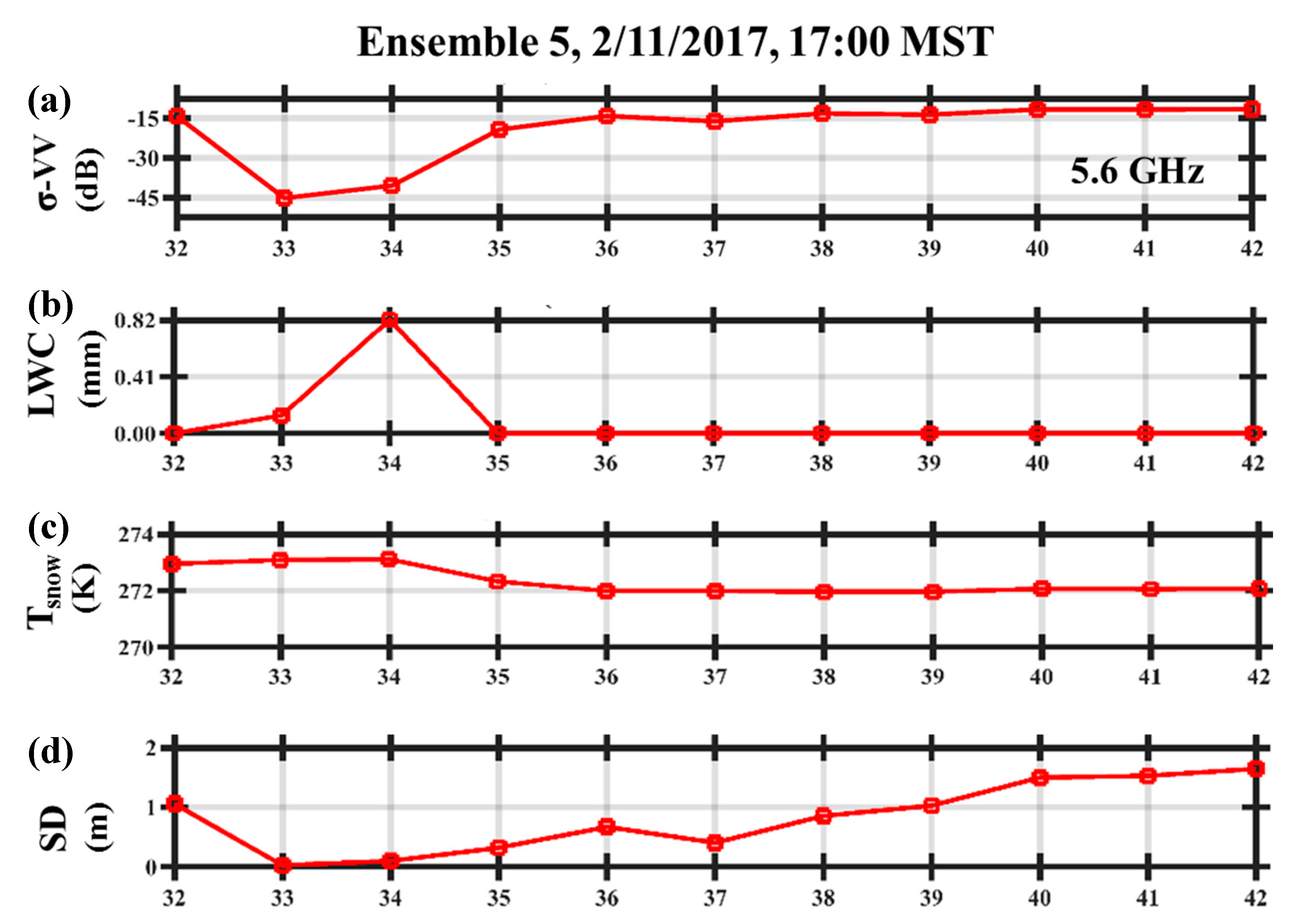Weather-Dependent Nonlinear Microwave Behavior of Seasonal High-Elevation Snowpacks
Abstract
:1. Introduction
2. Study Area and Datasets
2.1. Study Area
2.2. Atmospheric Forcing
2.2.1. European Center for Medium-Range Weather Forecasts (ECMWF)
2.2.2. High-Resolution Rapid Refresh (HRRR)
2.3. North American Land Data Assimilation System (NLDAS)
2.4. SnowEx’17 Field Campaign Data
3. Experimental Design
3.1. MSHM/MEMLS Modeling Framework
3.2. Ensemble Design
4. Results
4.1. Snowpack Hydrology
4.2. Snowpack Microwave Emissions and Scattering Behavior
5. Discussion
6. Conclusions
Supplementary Materials
Author Contributions
Funding
Acknowledgments
Conflicts of Interest
Appendix A. The Multilayer Snow Hydrology Model (MSHM)
Appendix A.1. Compaction
Appendix A.2. Snowpack Temperature
Appendix A.3. Conductance Factor and Aerodynamic Drag Coefficient
Appendix A.4. Melt
Appendix A.5. Rain-on-Snow
Appendix A.6. Dividing and Combining Snow Layers
Appendix A.7. Snow Correlation Length
Appendix B. The Microwave Emission Model of Layered Snowpacks (MEMLS)
Appendix C. Modified Wilmott Agreement Index [59]
- (=43) is the number of HRRR grids;
- is the number of snowpits within pixel p on day d, which is different for each pixel p;
- is the observed SWE (or snow depth) at site s within pixel p on day d;
- is the mean of the observations from all sites within pixel p on day d;
- is the ensemble mean on day d at time t = Tref.
References
- Hall, D.K. Assessment of Polar Climate Change Using Satellite Technology. Rev. Geophys. 1988, 26, 26–39. [Google Scholar] [CrossRef]
- Barnett, T.P.; Dumenil, L.; Schlese, U.; Roeckner, E.; Latif, M. The Effect of Eurasian Snow Cover on Regional and Global Climate Variations. J. Atmos. Sci. 1989, 46, 661–685. [Google Scholar] [CrossRef] [Green Version]
- Chapin, F.S.; Sturm, M.; Serreze, M.C.; McFadden, J.P.; Key, J.R.; Lloyd, A.H.; McGuire, A.D.; Rupp, T.S.; Lynch, A.H.; Schimel, J.P.; et al. Role of land-surface changes in Arctic summer warming. Science 2005, 310, 657–660. [Google Scholar] [CrossRef] [PubMed]
- Gustafsson, D.; Stahli, M.; Jansson, P.E. The surface energy balance of a snow cover: Comparing measurements to two different simulation models. Theor. Appl. Climatol. 2001, 70, 81–96. [Google Scholar] [CrossRef]
- Lemke, P.; Ren, J.; Alley, R.B.; Allison, I.; Carrasco, J.; Flato, G.; Fujii, Y.; Kaser, G.; Mote, P.; Thomas, R.H. Observations: Changes in Snow, Ice and Frozen Ground. 2007. Available online: http://ecite.utas.edu.au/100647 (accessed on 22 May 2015).
- Albert, M.R. Effects of snow and firn ventilation on sublimation rates. Ann. Glaciol. Ser. 2002, 35, 52–56. [Google Scholar] [CrossRef]
- Barnett, T.P.; Adam, J.C.; Lettenmaier, D.P. Potential impacts of a warming climate on water availability in snow-dominated regions. Nature 2005, 438, 303–309. [Google Scholar] [CrossRef]
- Painter, T.H.; Skiles, S.M.; Deems, J.S.; Brandt, W.T.; Dozier, J. Variation in Rising Limb of Colorado River Snowmelt Runoff Hydrograph Controlled by Dust Radiative Forcing in Snow. Geophys. Res. Lett. 2018, 45, 797–808. [Google Scholar] [CrossRef] [Green Version]
- Manickam, S.; Barros, A. Parsing Synthetic Aperture Radar Measurements of Snow in Complex Terrain: Scaling Behaviour and Sensitivity to Snow Wetness and Landcover. Remote Sens. 2020, 12, 483. [Google Scholar] [CrossRef] [Green Version]
- Schmugge, T.J.; Kustas, W.P.; Ritchie, J.C.; Jackson, T.J.; Rango, A. Remote sensing in hydrology. Adv. Water Resour. 2002, 25, 1367–1385. [Google Scholar] [CrossRef]
- Tedesco, M.; Kelly, R.E.J.; Foster, J.L.; Chang, A.T.C. AMSR-E/Aqua Daily L3 Global Snow Water Equivalent EASE-Grids V002; National Snow and Ice Data Center: Boulder, CO, USA, 2004. [Google Scholar]
- Lettenmaier, D.P.; Alsdorf, D.; Dozier, J.; Huffman, G.J.; Pan, M.; Wood, E.F. Inroads of remote sensing into hydrologic science during the WRR era. Water Resour. Res. 2015, 51, 7309–7342. [Google Scholar] [CrossRef]
- Hall, D. Passive Microwave Studies of Snowpack Properties; Goddard Space Flight Center: Greenbelt, MD, USA, 1978. [Google Scholar]
- Hall, D.; Foster, J.; Chang, A.; Rango, A. Passive microwave applications to snowpack monitoring using satellite data. 1979. Available online: https://ntrs.nasa.gov/citations/19790020478 (accessed on 3 September 2013).
- Rango, A.; Chang, A.; Foster, J. The utilization of spaceborne microwave radiometers for monitoring snowpack properties. Hydrol. Res. 1979, 10, 25–40. [Google Scholar] [CrossRef]
- Chang, A.; Foster, J.; Hall, D.K. Nimbus-7 SMMR derived global snow cover parameters. Ann. Glaciol. 1987, 9, 39–44. [Google Scholar] [CrossRef] [Green Version]
- Grody, N.C.; Basist, A.N. Global identification of snowcover using SSM/I measurements. IEEE Trans. Geosci. Remote Sens. 1996, 34, 237–249. [Google Scholar] [CrossRef]
- Tait, A.B. Estimation of snow water equivalent using passive microwave radiation data. Remote Sens. Environ. 1998, 64, 286–291. [Google Scholar] [CrossRef]
- Andreadis, K.M.; Liang, D.; Tsang, L.; Lettenmaier, D.P.; Josberger, E.G. Characterization of errors in a coupled snow hydrology-microwave emission model. J. Hydrometeorol. 2008, 9, 149–164. [Google Scholar] [CrossRef] [Green Version]
- Kang, D.H.; Barros, A.P. Observing System Simulation of Snow Microwave Emissions Over Data Sparse Regions-Part I: Single Layer Physics. IEEE Trans. Geosci. Remote Sens. 2012, 50, 1785–1805. [Google Scholar] [CrossRef]
- Kang, D.H.; Barros, A.P. Observing System Simulation of Snow Microwave Emissions Over Data Sparse Regions-Part II: Multilayer Physics. IEEE Trans. Geosci. Remote Sens. 2012, 50, 1806–1820. [Google Scholar] [CrossRef]
- Kang, D.H.; Barros, A.P.; Dery, S.J. Evaluating Passive Microwave Radiometry for the Dynamical Transition From Dry to Wet Snowpacks. IEEE Trans. Geosci. Remote Sens. 2014, 52, 3–15. [Google Scholar] [CrossRef]
- Tedesco, M.; Kim, E.J.; England, A.W.; De Roo, R.D.; Hardy, J.P. Brightness Temperatures of Snow Melting/Refreezing Cycles: Observations and Modeling Using a Multilayer Dense Medium Theory-Based Model. IEEE Trans. Geosci. Remote Sens. 2006, 44, 3563–3573. [Google Scholar] [CrossRef]
- Foster, J.L.; Sun, C.J.; Walker, J.P.; Kelly, R.; Chang, A.; Dong, J.R.; Powell, H. Quantifying the uncertainty in passive microwave snow water equivalent observations. Remote Sens. Environ. 2005, 94, 187–203. [Google Scholar] [CrossRef]
- Langlois, A.; Royer, A.; Derksen, C.; Montpetit, B.; Dupont, F.; Goita, K. Coupling the snow thermodynamic model SNOWPACK with the microwave emission model of layered snowpacks for subarctic and arctic snow water equivalent retrievals. Water Resour. Res. 2012, 48, W12524. [Google Scholar] [CrossRef] [Green Version]
- Rotschky, G.; Rack, W.; Dierking, W.; Oerter, H. Retrieving snowpack properties and accumulation estimates from a combination of SAR and scatterometer measurements. IEEE Trans. Geosci. Remote Sens. 2006, 44, 943–956. [Google Scholar] [CrossRef]
- Raleigh, M.S.; Lundquist, J.D.; Clark, M.P. Exploring the impact of forcing error characteristics on physically based snow simulations within a global sensitivity analysis framework. Hydrol. Earth Syst. Sci. 2015, 19, 3153–3179. [Google Scholar] [CrossRef] [Green Version]
- Larue, F.; Royer, A.; De Sève, D.; Roy, A.; Picard, G.; Vionnet, V.; Cosme, E. Simulation and assimilation of passive microwave data using a snowpack model coupled to a calibrated radiative transfer model over northeastern Canada. Water Resour. Res. 2018, 54, 4823–4848. [Google Scholar] [CrossRef]
- Xue, Y.; Forman, B.A.; Reichle, R.H. Estimating Snow Mass in North America Through Assimilation of Advanced Microwave Scanning Radiometer Brightness Temperature Observations Using the Catchment Land Surface Model and Support Vector Machines. Water Resour. Res. 2018, 54, 6488–6509. [Google Scholar] [CrossRef]
- Dechant, C.; Moradkhani, H. Radiance data assimilation for operational snow and streamflow forecasting. Adv. Water Resour. 2011, 34, 351–364. [Google Scholar] [CrossRef]
- De Lannoy, G.J.M.; Reichle, R.H.; Arsenault, K.R.; Houser, P.R.; Kumar, S.; Verhoest, N.E.C.; Pauwels, V.R.N. Multiscale assimilation of Advanced Microwave Scanning Radiometer-EOS snow water equivalent and Moderate Resolution Imaging Spectroradiometer snow cover fraction observations in northern Colorado. Water Resour. Res. 2012, 48, W01522. [Google Scholar] [CrossRef]
- Charrois, L.; Cosme, E.; Dumont, M.; Lafaysse, M.; Morin, S.; Libois, Q.; Picard, G. On the assimilation of optical reflectances and snow depth observations into a detailed snowpack model. Cryosphere 2016, 10, 1021–1038. [Google Scholar] [CrossRef] [Green Version]
- Kim, E.; Gatebe, C.; Hall, D.; Newlin, J.; Misakonis, A.; Elder, K.; Marshall, H.P.; Hiemstra, C.; Brucker, L.; De Marco, E. NASA’s SnowEx campaign: Observing seasonal snow in a forested environment. In Proceedings of 2017 IEEE International Geoscience and Remote Sensing Symposium (IGARSS). pp. 1388–1390. Available online: https://ieeexplore.ieee.org/abstract/document/8127222?casa_token=SredIaGpftsAAAAA:6rxIQhYyCb3fkNgdfbE_YH67staRkP_vMJ8nm_rpDYIKx43DUfvQeA_Saosi-x1ykc909cUn1uE1 (accessed on 4 December 2017).
- Durand, M.; Kim, E.J.; Margulis, S.A. Quantifying Uncertainty in Modeling Snow Microwave Radiance for a Mountain Snowpack at the Point-Scale, Including Stratigraphic Effects. IEEE Trans. Geosci. Remote Sens. 2008, 46, 1753–1767. [Google Scholar] [CrossRef]
- Proksch, M.; Matzler, C.; Wiesmann, A.; Lemmetyinen, J.; Schwank, M.; Lowe, H.; Schneebeli, M. MEMLS3&a: Microwave Emission Model of Layered Snowpacks adapted to include backscattering. Geosci. Model. Dev. 2015, 8, 2611–2626. [Google Scholar]
- Wiesmann, A.; Matzler, C. Microwave emission model of layered snowpacks. Remote Sens. Environ. 1999, 70, 307–316. [Google Scholar] [CrossRef]
- Benjamin, S.G.; Weygandt, S.S.; Brown, J.M.; Hu, M.; Alexander, C.R.; Smirnova, T.G.; Olson, J.B.; James, E.P.; Dowell, D.C.; Grell, G.A.; et al. A North American Hourly Assimilation and Model Forecast Cycle: The Rapid Refresh. Mon. Weather Rev. 2016, 144, 1669–1694. [Google Scholar] [CrossRef]
- Blaylock, B.K.; Horel, J.D.; Liston, S.T. Cloud archiving and data mining of High-Resolution Rapid Refresh forecast model output. Comput. Geosci. 2017, 109, 43–50. [Google Scholar] [CrossRef]
- Xia, Y.L.; Mitchell, K.; Ek, M.; Sheffield, J.; Cosgrove, B.; Wood, E.; Luo, L.F.; Alonge, C.; Wei, H.L.; Meng, J.; et al. Continental-scale water and energy flux analysis and validation for the North American Land Data Assimilation System project phase 2 (NLDAS-2): 1. Intercomparison and application of model products. J. Geophys. Res. Atmos. 2012, 117, D03109. [Google Scholar] [CrossRef]
- Elder, K.; Brucker, L.; Hiemstra, C.; Marshall, H. SnowEx17 Community Snow Pit Measurements; Version 1; NASA National Snow and Ice Data Center Distributed Active Archive Center: Boulder, CO, USA, 2018. [Google Scholar] [CrossRef]
- Devonec, E.; Barros, A.P. Exploring the transferability of a land-surface hydrology model. J. Hydrol. 2002, 265, 258–282. [Google Scholar] [CrossRef]
- Bindlish, R.; Barros, A.P. Aggregation of digital terrain data using a modified fractal interpolation scheme. Comput. Geosci. 1996, 22, 907–917. [Google Scholar] [CrossRef]
- Liao, M.; Ana, P.B. GPM Ground Validation Reference Precipitation IPHEx; NASA Global Hydrology Resource Center DAAC: Huntsville, AL, USA, 2019. [Google Scholar] [CrossRef]
- Nogueira, M.; Barros, A.P. Transient stochastic downscaling of quantitative precipitation estimates for hydrological applications. J. Hydrol. 2015, 529, 1407–1421. [Google Scholar] [CrossRef]
- Tao, K.; Barros, A.P. Using Fractal Downscaling of Satellite Precipitation Products for Hydrometeorological Applications. J. Atmos. Ocean. Tech. 2010, 27, 409–427. [Google Scholar] [CrossRef] [Green Version]
- Mortimer, C.; Mudryk, L.; Derksen, C.; Luojus, K.; Brown, R.; Kelly, R.; Tedesco, M. Evaluation of long-term Northern Hemisphere snow water equivalent products. Cryosphere 2020, 14, 1579–1594. [Google Scholar] [CrossRef]
- Tao, J.; Barros, A.P. Multi-year atmospheric forcing datasets for hydrologic modeling in regions of complex terrain—Methodology and evaluation over the Integrated Precipitation and Hydrology Experiment 2014 domain. J. Hydrol. 2018, 567, 824–842. [Google Scholar] [CrossRef]
- Raleigh, M.S.; Livneh, B.; Lapo, K.; Lundquist, J.D. How Does Availability of Meteorological Forcing Data Impact Physically Based Snowpack Simulations? J. Hydrometeorol. 2016, 17, 99–120. [Google Scholar] [CrossRef]
- Board, S.S. National Academies of Sciences, Engineering, and Medicine. In Thriving on Our Changing Planet: A Decadal Strategy for Earth Observation from Space; National Academies Press: Washington, DC, USA, 2019. [Google Scholar]
- Roy, A.; Langlois, A.; Brucker, L. SnowEx17 Radiometrics Surface-Based Radiometer Brightness Temperatures, Version 1; NASA National Snow and Ice Data Center Distributed Active Archive Center: Boulder, CO, USA, 2019. [Google Scholar] [CrossRef]
- Rautiainen, K.; Lemmetyinen, J.; Pulliainen, J.; Vehvilainen, J.; Drusch, M.; Kontu, A.; Kainulainen, J.; Seppanen, J. L-band radiometer observations of soil processes in boreal and subarctic environments. IEEE Trans. Geosci. Remote Sens. 2011, 50, 1483–1497. [Google Scholar] [CrossRef]
- Yurchak, B.S. Effect of Snow Density Irregularities on Radar Backscatter from a Layered Dry Snow Pack. Prog. Electromagn. Res. 2014, 59, 181–191. [Google Scholar] [CrossRef] [Green Version]
- Oveisgharan, S.; Esteban-Fernandez, D.; Waliser, D.; Friedl, R.; Nghiem, S.; Zeng, X. Evaluating the Preconditions of Two Remote Sensing SWE Retrieval Algorithms over the US. Remote Sens. 2020, 12. [Google Scholar] [CrossRef]
- Schwank, M.; Rautiainen, K.; Mätzler, C.; Stähli, M.; Lemmetyinen, J.; Pulliainen, J.; Vehviläinen, J.; Kontu, A.; Ikonen, J.; Ménard, C.B. Model for microwave emission of a snow-covered ground with focus on L band. Remote Sens. Environ. 2014, 154, 180–191. [Google Scholar] [CrossRef]
- Bernier, M.; Fortin, J.-P. The potential of times series of C-band SAR data to monitor dry and shallow snow cover. IEEE Trans. Geosci. Remote Sens. 1998, 36, 226–243. [Google Scholar] [CrossRef]
- Du, J.; Kimball, J.S.; Moghaddam, M. Theoretical modeling and analysis of l-and p-band radar backscatter sensitivity to soil active layer dielectric variations. Remote Sens. 2015, 7, 9450–9472. [Google Scholar] [CrossRef] [Green Version]
- Mätzler, C.; Hüppi, R. Review of signature studies for microwave remote sensing of snowpacks. Adv. Space Res. 1989, 9, 253–265. [Google Scholar] [CrossRef]
- Ulaby, F.T.; Stiles, W.H. Microwave response of snow. Adv. Space Res. 1981, 1, 131–149. [Google Scholar] [CrossRef]
- Willmott, C.J.; Robeson, S.M.; Matsuura, K. A refined index of model performance. Int. J. Climatol. 2012, 32, 2088–2094. [Google Scholar] [CrossRef]
- Löwe, H.; Spiegel, J.; Schneebeli, M. Interfacial and structural relaxations of snow under isothermal conditions. J. Glaciol. 2011, 57, 499–510. [Google Scholar] [CrossRef] [Green Version]
- Louis, J.-F. A parametric model of vertical eddy fluxes in the atmosphere. Bound. Layer Meteorol. 1979, 17, 187–202. [Google Scholar] [CrossRef]
- Lehning, M.; Bartelt, P.; Brown, B.; Fierz, C.; Satyawali, P. A physical SNOWPACK model for the Swiss avalanche warning Part II: Snow microstructure. Cold Reg. Sci. Technol. 2002, 35, 147–167. [Google Scholar] [CrossRef]
- Wiesmann, A.; Fierz, C.; Matzler, C. Simulation of microwave emission from physically modeled snowpacks. Ann. Glaciol. 2000, 31, 397–405. [Google Scholar] [CrossRef] [Green Version]



















| Ensemble | 0 | 1 | 2 | 3 | 4 | 5 |
|---|---|---|---|---|---|---|
| Air temperature (K) | ECMWF | HRRR | HRRR | HRRR | HRRR | HRRR |
| Snowfall rate (kg/m2/s) | ECMWF | ECMWF | HRRR | HRRR | HRRR | HRRR |
| Rainfall rate (kg/m2/s) | ECMWF | ECMWF | HRRR | HRRR | HRRR | HRRR |
| Air pressure (Pa) | HRRR | HRRR | HRRR | HRRR | HRRR | HRRR |
| Incoming shortwave radiation (W/m2) | ECMWF | ECMWF | ECMWF | ECMWF | ECMWF | HRRR |
| Incoming longwave radiation (W/m2) | ECMWF | ECMWF | ECMWF | ECMWF | ECMWF | HRRR |
| Albedo | NLDAS | NLDAS | NLDAS | NLDAS | NLDAS | NLDAS |
| Windspeed (m/s) | ECMWF | ECMWF | ECMWF | HRRR | HRRR | HRRR |
| Specific humidity (kg/kg) | ECMWF | ECMWF | ECMWF | ECMWF | HRRR | HRRR |
| Ensemble Size | 387 | 387 | 387 | 387 | 387 | 43 |
| Frequency (GHz) | 1.3, 5.6, 13.5, and 35.7 GHz |
|---|---|
| Incidence angle (º) | 50 |
| Snow-ground reflectivity, h-pol | 0 |
| Snow-ground reflectivity, v-pol | 0 |
| Specular part of snow-ground reflectivity, h-pol | 0 |
| Specular part of snow-ground reflectivity, v-pol | 0 |
| Sky brightness temperature (K) | 0 |
| Type of scattering coefficient | 11 |
| Mean slope of snow surface undulations | 0.1 |
| Cross polarization fraction * | 0.2 |
| Snow salinity (parts per thousand) | 0 |
Publisher’s Note: MDPI stays neutral with regard to jurisdictional claims in published maps and institutional affiliations. |
© 2020 by the authors. Licensee MDPI, Basel, Switzerland. This article is an open access article distributed under the terms and conditions of the Creative Commons Attribution (CC BY) license (http://creativecommons.org/licenses/by/4.0/).
Share and Cite
Cao, Y.; Barros, A.P. Weather-Dependent Nonlinear Microwave Behavior of Seasonal High-Elevation Snowpacks. Remote Sens. 2020, 12, 3422. https://doi.org/10.3390/rs12203422
Cao Y, Barros AP. Weather-Dependent Nonlinear Microwave Behavior of Seasonal High-Elevation Snowpacks. Remote Sensing. 2020; 12(20):3422. https://doi.org/10.3390/rs12203422
Chicago/Turabian StyleCao, Yueqian, and Ana P. Barros. 2020. "Weather-Dependent Nonlinear Microwave Behavior of Seasonal High-Elevation Snowpacks" Remote Sensing 12, no. 20: 3422. https://doi.org/10.3390/rs12203422







